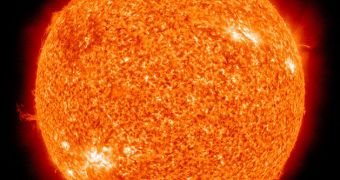For many years, climate scientists have argued that some of the blame for the extent of global warming can be attributed to the Sun, but exactly how much has been a matter of debate. Now, a new center will seek to understand and quantify those influences.
Those who say that the Sun is not influencing our planet obviously have no clues of what goes on in the upper atmosphere. Just the same, those who say that all the pollution released by mankind holds nothing against the Sun are wrong as well.
The truth is somewhere in the middle, experts believe, in the sense that the devastating effects of pollution are being augmented to some extent by those of the Sun.
As such, the goal of the new Sun-Climate Research Center (SCRC) will be to determine the exact influence that the star has on global warming and climate change, so as to settle the ongoing debate once and for all.
The organization is a collaborative effort of the NASA Goddard Space Flight Center (GSFC) and the Laboratory for Atmospheric and Space Physics (LASP) at the University of Colorado.
Robert Cahalan, the head of the GSFC Climate and Radiation Branch, will direct the SCRC, together with the head of the GSFC Solar Physics Laboratory, Douglas Rabin, and LASP research scientistP eter Pilewskie, who is also a professor at the university.
“In recent years Goddard and LASP have worked together on several Earth and Sun missions,” explains Cahalan. These cooperative efforts helped further climate sciences considerably.
“Now we look forward to continuing to drive growth in this key interdisciplinary field of Sun-Earth research, bringing new focus to the study of multiyear changes in the Sun and their influence on Earth's climate,” the official adds.
“The exciting thing about this collaboration is that we believe it will promote studies to help answer a key question about the climate system: how does Earth's atmosphere respond to the sun's variability, and how does that affect climate?” Pilewskie asks.
“This question is particularly important now, as we seek to quantify the human-induced impact on Earth's climate,” he goes on to say.
As part of the SCRC, researchers at both GSFC and LASP will be able to collaborate through exchange programs, symposiums, and other research opportunities.
The new lab mostly addresses graduate students and post-doctoral researchers in fields such as science, engineering, and mission operations.
“I am very excited that we have been able to craft this agreement that brings together the best scientists at NASA and LASP to study how the Earth responds to changes in the solar energy output,” says Dr. Nicholas White, quoted by SpaceRef.
“The sum of the two will exceed what the individual entities could achieve on their own,” concludes the expert, who is the director of the GSFC Sciences and Exploration Directorate.

 14 DAY TRIAL //
14 DAY TRIAL //